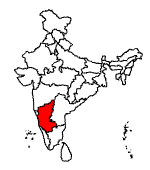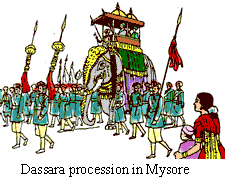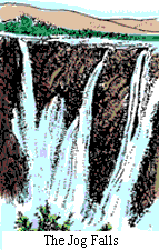
Dimdima
Online Children's Magazine from India

Dimdima
Online Children's Magazine from India
Situated on the western edge of the Deccan plateau, the coastal state of Karnataka is the 8th largest state both in terms of area and population.
Area : 1,91,791 sq.km
Population : 5,27,33,958
Languages : The official language is Kannada.
Capital : Bangalore
Location :
On the west it has a 320-kilometre-long coastline fringing the Arabian Sea. Goa and Maharashtra are its northwestern and northern neighbours, Andhra Pradesh forms its eastern border while in the south it has boundaries with Kerala and Tamil Nadu.
Major Cities :
Mysore, Hubli, Dharwar, Mangalore, Belgaum, Bijapur and Gulburga.
Rivers :
The Krishna and its tributaries in the north and the Kaveri and its tributaries in the south are the two important river systems. All these rivers flow eastward and empty into the Bay of Bengal. There are innumerable smaller rivers in the coastal region which rise in the Western Ghats and flow westward into the Arabian Sea.
Crops :
Rice is the major crop. Jowar, ragi, millet and pulses are also grown. Sugarcane, arecanut and coffee are cash crops — 59 per cent of the coffee grown in India comes from Karnataka. The state produces most of the world's sandalwood oil.
Different parts of the state we now call Karnataka were ruled by different dynasties at various times. The earliest inscriptions to be found in Karnataka are those of Asoka.
The Kadambas who came to power in the middle of the 4th century A.D ruled for over 200 years. The beautiful Kannada script took shape during Kadamba rule.
While the Kadambas ruled in the north the Gangas ruled the southern parts of the state from the 4th century to the 10th century A.D. The Gangas contributed greatly to the art and culture of Karnataka. The monolithic statue of Gomateshwara at Sravanabelagola was created during the Ganga period.
Other dynasties that held sway over large parts of Karnataka at various times were the Satavahanas, the Chalukyas, the Rashtrakutas and the Hoysalas.
The last great empire of which Karnataka was the base was the Vijayanagar empire.
During British rule, Kannada-speaking people were scattered among the princely states of Mysore, Hyderabad and the British provinces of Bombay, Madras and the small territory of Coorg.
After independence they were able to come together in a single state which had Mysore as its nucleus.
The new state was at first called Mysore but on November 1, 1973 the name was changed to Karnataka.
Karnataka is famous for its goldfields — which have now closed down — and sandalwood.
Three-fourths of the people live in the countryside but Bangalore, the capital, is one of our fastest growing cities. Its pulsating computer industry and the technological and scientific research being carried on in the city draw scientists, students and businessmen from all over India and abroad, giving Bangalore a cosmopolitan air.
According to legend Bangalore was founded in 1537 by a feudal chieftain named Kempe Gowda at a spot where he was given a handful of boiled beans by an old woman, when he was lost in the forest. Bangalore means 'city of boiled beans'.
Bangalore has beautiful parks and was once known as the 'garden city'.
Mysore is famous for its palaces and the Dassara festival which is celebrated in traditional pomp and splendour here during September-October. The Krishnaraja Sagar dam and the fabulous Brindavan gardens stretching out in terraces below it are nearby.
A Muslim saint Babu Budan introduced coffee beans into India in the 1600's and planted them in the south of Karnataka. Today Karnataka produces two-thirds of all the coffee grown in India.
Hampi the capital of the mighty Vijayanagar empire drew travellers from all over Europe and Asia in its heyday; today its magnificent ruins draw tourists from all over the world. Srirangapattna the island fort, once the capital of Hyder Ali and Tipu Sultan is another tourist attraction.
Bijapur's Gol Gumbaj the tomb of Mohammad Adil Shah, was built in 1659. It has the second largest dome in the world.
For those interested in wildlife, Nagarhole and Bandipur are excellent sanctuaries especially for viewing elephants and gaur.



Dimdima is the Sanskrit word for ‘drumbeat’. In olden days, victory in battle was heralded by the beat of drums or any important news to be conveyed to the people used to be accompanied with drumbeats.
Bharatiya Vidya Bhavan
K. M Munshi Marg,
Chowpatty, Mumbai - 400 007
email : editor@dimdima.com
Bharatiya Vidya Bhavan
505, Sane Guruji Marg,
Tardeo, Mumbai - 400 034
email : promo@dimdima.com
Dimdima.com, the Children's Website of Bharatiya Vidya Bhavan launched in 2000 and came out with a Printed version of Dimdima Magazine in 2004. At present the Printed Version have more than 35,000 subscribers from India and Abroad.